The TV Show That Menaced Metropolis!
In Action Comics #422 (Mar. 1973), writer Cary
Bates and artists Curt
Swan and Murphy Anderson explore
the dangers of professional jealousy, excessive TV-watching
and auto-immune systems that work a little too well.
Our story begins "16 years ago" when a "very
wealthy couple" is blessed with a baby boy, only to
have a team of doctors tell them the child must never, ever
leave his room. Afflicted with an extraordinary ailment
never seen before, the only safe course of action is lifelong
quarantine. "Contact with the outside air," they
warn, " -- even for a moment -- might cause disaster!'
Now we return to the present to find young Woodrow Nescott
a teenager, having spent his life in his room with a television
as his only "companion." As he waits for his favorite
show, The Runaway, Woodrow watches WGBS correspondent
Clark Kent reporting live from a Metropolis
subway terminal.
As soon as Clark ends his report, a passenger is suddenly
pushed from the platform into the path of an oncoming train.
After creating a distraction for his camera crew, Clark
changes to Superman and saves the imperiled passenger.
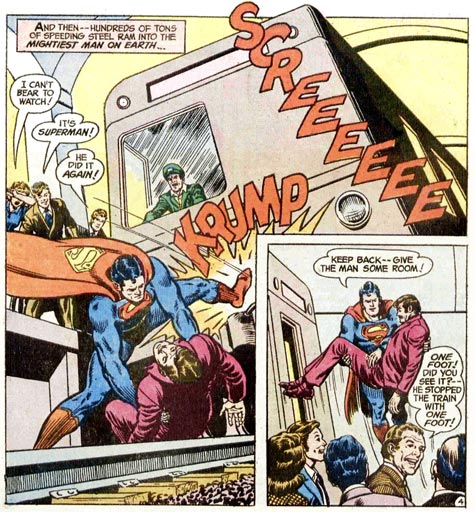
The other passengers recognize the intended victim as television
actor Dan Marz, who plays "Police
Agent Y-6" on Woodrow's favorite show. The Runaway,
we learn, is the tale of "Rolf Kimb," an innocent
man from the year 2272, wrongly convicted of a crime he
didn't commit and fleeing Agent Y-6 by traveling back in
time to the 20th Century.
Even now, young Woodrow is watching the latest episode
of The Runaway, in which Agent Y-6 has just laid
a trap for Rolf Kimb, one that will send Kimb back to the
year 2272 to face execution. Beside himself with worry for
his TV hero, Woodrow has an urgent question for his parents...
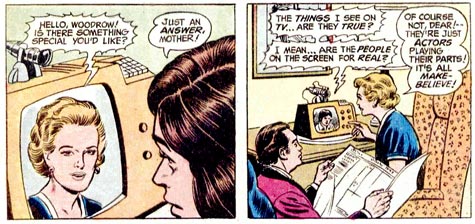
Woodrow's mom reassures him that the people he sees on
TV are not real, but it just so happens that he recently
saw Superman in action with his own eyes, saving a helicopter
within view of his bedroom window, and prior to that sighting
Superman -- a rather amazing character, you must admit --
had only been known to him through television. So if Superman
isn't make-believe, Woodrow reasons, then his parents must
be lying to him and everyone on TV is in fact real. And
in that case, he has to warn Rolk Kimb of Agent Y-6's trap.
So it is that Woodrow sets a fire in his room, activating
an emergency door that allows him to escape his house for
the first time in his life.
The next day, Clark Kent interviews actor Mac Nelson, better
known as "Rolf Kimb," and learns that he's been
let go from The Runaway, his own popularity having
waned compared to audience favorite Dan Marz. The next episode,
he tells Clark, will find his character returned to the
future, allowing Agent Y-6 to take over the show. From his
thought balloons, we learn it was he who pushed Marz into
the path of the train, figuring the network would have to
keep him on with Marz dead. Meanwhile outside his hotel
window is an amazing sight:
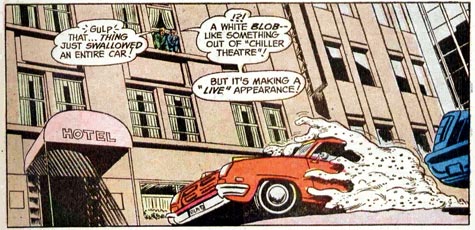
Clark rushes off, ostensibly to cover the breaking story
and, as Superman, tangles with the mysterious blob, which
seems to be headed straight for a nearby hospital. Unable
to land a decent punch on the gelatinous form, he finally
settles for throwing it into Earth orbit. Looking on from
the imperiled hospital are a group of doctors who know exactly
what the "blob" really is. They reveal to Superman
that it is in fact a single leucocyte -- or white blood
cell -- from the body of Woodrow Nescott. This is the nature
of the boy's disease; contact with the outside air makes
his white blood cells quickly grow millions of times larger,
endangering everything around them.
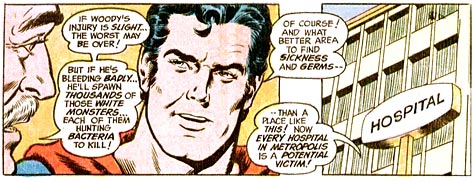
Meanwhile Mac Nelson is surprised to find
young Woody Nescott climbing in through his hotel window,
convinced he's really "Rolf Kimb". "You've
got to listen to me!" warns Woody. "Agent Y-6
is out to get you...with an ultimate weapon!"
Convinced the boy is off his nut, Nelson exploits his delusions
by asking him to deal with Agent Y-6. He hands Woody a "time
reverser" prop from his TV show -- which unknown to
the boy has been modified to fire real bullets -- and points
him toward Metro Clinic, where Dan Marz is recovering from
his fall in the subway. Shoot this at Y-6, he says, and
he'll be sent to the future. Unfortunately for Nelson, however,
Woody sustains a small cut from a thorny bush as he walks
away, unleashing another monster.
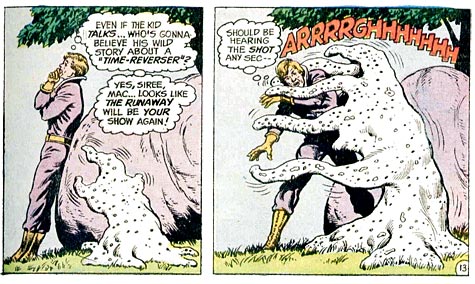
In Dan Marz' hospital room, Woody is about to pull the
trigger on the "time reverser" when the blob smashes
through the window. Luckily Superman is close behind, grabbing
the blob and sending it into orbit with its predecessor.
In an epilog, we learn Superman searched the galaxy for
a cure to young Woody's ailment, finally locating an alien
herb that did the trick, allowing Woody to live a normal
life in the outside world. The Runaway program
was re-titled The Cases of Agent Y-6 and went on
to even greater popularity, and the murderous Mac Nelson
was never heard from again, his body having been devoured
by the giant white blood cell which will circle the Earth
forever.
This is a solid entry from all concerned, really. Bates
manages a real sense of tension, impressive given the silliness
of the concept, and Nelson's demise is genuinely creepy.
The plot is obviously inspired by the much-publicized plight
of young
Ted DeVita and David
Vetter, boys whose lack of effective immune systems
led to their living out their lives in artificially maintained
isolation rooms, and whose stories would soon inspire the
film, The Boy In the Plastic Bubble (starring an
up-and-coming young superstar named John Travolta).
In their case, exposure to the outside world would have
brought quick death to themselves, but in the case of the
fictional Woody -- whose immune system works too well --
it imperils everyone else.
The Runaway is an obvious nod to The Fugitive,
right down to the "Rolk Kimb" name, an obvious
take-off on David Janssen's "Richard
Kimble" character. It wouldn't be the last time the
show mixed with comics; in a couple of years CBS would combine
the formula with super-heroics to produce the hit series,
The Incredible Hulk.
It almost goes without saying that the art by Curt Swan
and Murphy Anderson is top-drawer, and it's always fun to
see our hero with the slightly longer hair and groovy long
sideburns of the period.
Icing on the cake for this issue is the back-up feature,
giving us the origin of the Human Target
with great art by Dick Giordano. Throw
in a typically gorgeous cover by the legendary Nick
Cardy, and this is definitely one to seek out
in the back-issue bins.





